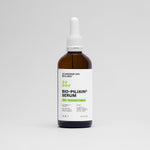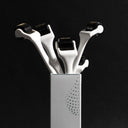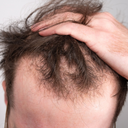Are you struggling with hair loss and wondering which treatment might give you the best results? You're not alone!
Exosomes and PRP (platelet-rich plasma) are two popular options that promise to rejuvenate your hair. But how do they compare?
Let’s explore the key differences between these two therapies and help you decide which one might be a better fit for your needs.
Table of content
What is exosome hair loss therapy?

Exosome hair loss therapy is a cutting-edge regenerative treatment that uses stem cell-derived exosomes to stimulate hair follicles and promote new hair growth. These tiny vesicles contain vital information in the form of DNA, RNA, and proteins, which signal cells to regenerate and grow. Injected into the scalp, exosomes penetrate deeply, encouraging hair regeneration from the inside out.
Exosomes, tiny signaling molecules, act like messengers between cells, directing them to perform specific actions such as growing or dividing.
Derived from human amniotic mesenchymal stem cells, exosomes in hair therapy carry powerful regenerative properties, helping to stimulate damaged hair follicles and promote healthy growth.
With over 95 clinical trials investigating their effects, exosome therapy is showing promising results, particularly for individuals who haven’t responded well to traditional treatments.
As your leading source for hair health information over the past 4 years, we never compromise on accuracy. When it comes to your health, you deserve information you can truly rely on - and earning your trust is our top priority.
Here's how Scandinavian Biolabs ensures every piece of content meets the highest standards of accuracy and integrity:
- Credentialed Experts: Our reviewers are actively practicing doctors and medical researchers
- Stringent Reviews: Content undergoes rigorous editing by subject specialists and review by a practicing doctor.
- Evidence-Based: We rely on well-established research from trusted scientific sources like peer-reviewed journals and health authorities.
- Full Transparency: Our editorial standards, writer credentials, reviewer credentials, correction process, and funding are all publicly documented.
- Independent Voice: While we do promote products, we operate in a vacuum to business operations. Our main goal is just an unwavering commitment to providing medically-sound guidance.
You can count on Scandinavian Biolabs to consistently deliver the trustworthy health information you deserve. Read our Editorial Standards.
How does exosome hair loss therapy work?
Exosome therapy starts with isolating and purifying exosomes from stem cells. These exosomes are then injected into areas of the scalp where hair loss is most prominent. Once on the scalp, they communicate with surrounding cells, sending signals that promote cell regeneration and stimulate hair follicles.
Because exosomes are so tiny, they can penetrate deep into the tissue, allowing for more effective treatment. This therapy not only encourages new hair growth but also helps improve the overall health and strength of the existing hair.
Pros and cons of exosome hair therapy
Exosome hair therapy offers several advantages, but it’s essential to weigh the pros and cons.
Pros:
- Minimally invasive
- Encourages natural hair regrowth
- Suitable for people with thinning or genetic hair loss
- Requires fewer sessions than other treatments
Cons:
- Still relatively new, with long-term results being studied
- It can be expensive compared to other treatments
- It may not be as effective for severe hair loss cases
What is PRP (platelet-rich plasma) therapy?

PRP therapy is a popular treatment that uses your blood’s platelets to stimulate hair growth. In this process, blood is drawn, and the plasma, rich in platelets, is separated and injected into the scalp to promote hair follicle rejuvenation.
This therapy works by utilizing the body's natural growth factors to encourage hair regeneration. The idea is to use your body’s healing abilities to restore thinning hair and enhance hair follicle health.
How does PRP work?
In PRP therapy, blood is drawn from the patient, typically from the arm. The blood is then placed in a centrifuge to separate the platelet-rich plasma from the rest of the blood components. The concentrated platelets are injected into the areas of the scalp experiencing hair loss.
Once injected, these platelets release growth factors that stimulate hair follicle activity. This process helps improve blood supply to the follicles, encouraging the growth of healthier and stronger hair.
PRP therapy typically requires multiple sessions to achieve the best results, with many patients noticing improvements after the second or third treatment. However, results may vary depending on the severity of the individual's hair loss.
Pros and cons of PRP therapy
PRP therapy has its own set of benefits and drawbacks.
Pros:
- Uses the patient’s own blood, reducing the risk of allergic reactions
- Non-surgical and minimally invasive
- Suitable for early stages of hair thinning
Cons:
- Results may take time and require multiple sessions
- May not be effective for more advanced hair loss
- Some patients experience mild discomfort during the procedure
Are there any risks?
Since PRP and Exosome therapies involve using your own blood and cells, the risks are quite minimal. Most patients experience mild irritation and redness at the injection sites, which typically fades after a few days. In rare cases, slight swelling or bruising may occur, lasting up to a week.
What makes these treatments appealing is that they carry no risk of disease transmission or allergic reactions.
Since both platelets and exosomes come from your own body, there's no chance of an immunological response.
However, it's important to undergo a thorough health screening before these treatments to ensure there are no underlying health conditions that could interfere with your therapy.
Key considerations:
- Mild irritation or redness may occur at injection sites
- Slight swelling or bruising in rare cases
- No risk of disease transmission or allergic reactions
- Comprehensive health screening is required before treatment
A better approach for your overall hair health

If you're looking for a non-invasive option to support your hair growth, Bio-Pilixin® Serum could be a great alternative. Developed by experts, this plant-based serum uses stem cell technology to help nurture your hair follicles and stimulate growth.
By improving blood flow to your scalp, Bio-Pilixin® supplies essential nutrients that your hair needs to thrive.
What sets Bio-Pilixin® apart is that it’s drug-free, making it safe for daily use without the risk of disrupting your hormones or metabolism. It works in harmony with your body to encourage natural hair growth without any harsh side effects.
Bio-Pilixin® has been tested in clinical trials, and the results are promising. Over 93% of participants reported a noticeable reduction in hair loss within 150 days, and 73% saw an increase in hair density. It's a natural way to give your hair a boost without committing to more invasive treatments.
If you’re tired of seeing hair shed in the shower, Bio-Pilixin® could be the game-changer you’ve been looking for. And with a 150-day money-back guarantee, you can try it risk-free to see if it’s the right solution for you.
Exosomes hair loss therapy vs PRP hair loss treatment: Which is better?
Both exosome therapy and PRP offer unique benefits, but exosomes tend to show faster results and may require fewer sessions. PRP is a more established option, but exosome therapy is gaining attention for its effectiveness in more challenging cases of hair loss.
Conclusion
When it comes to deciding between exosome therapy and PRP, it ultimately depends on your specific needs. Exosome therapy may be a better fit if you’re looking for quicker, more potent results, while PRP is a trusted option for more general hair thinning.
If you're not ready to commit to either treatment, Bio-Pilixin® Serum is an excellent alternative. It supports hair growth naturally, is safe for daily use, and comes with a 150-day money-back guarantee—so you’ve got nothing to lose except excess hair!
References:






